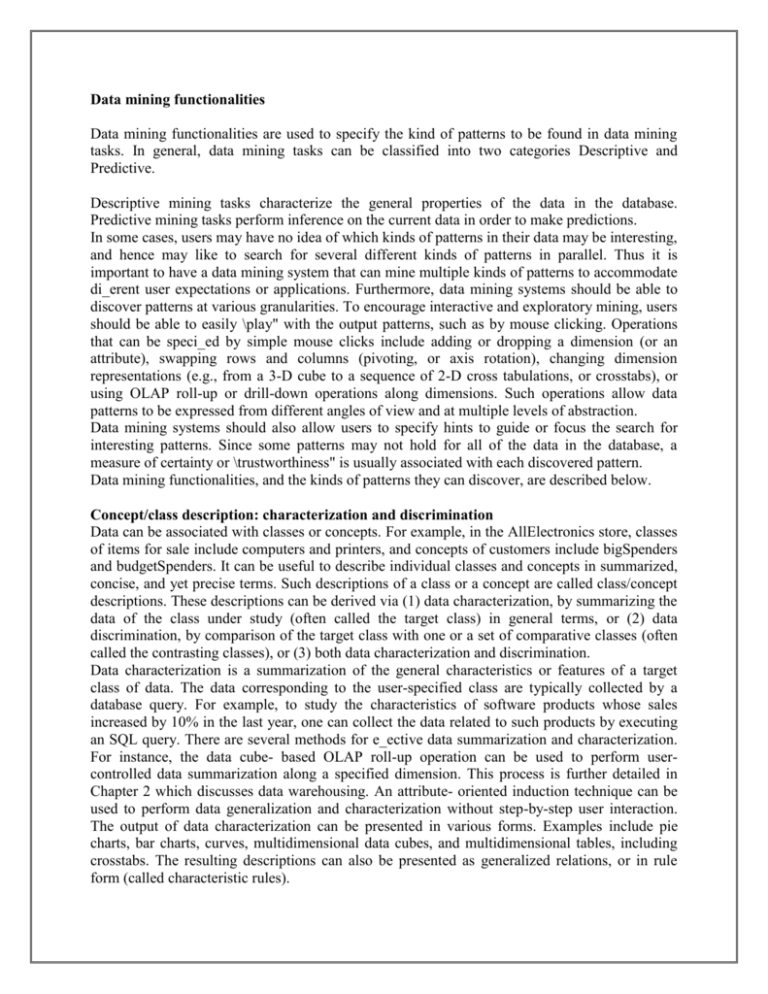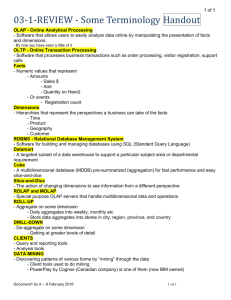Data Mining Functionalities: Descriptive & Predictive Tasks
advertisement

Data mining functionalities Data mining functionalities are used to specify the kind of patterns to be found in data mining tasks. In general, data mining tasks can be classified into two categories Descriptive and Predictive. Descriptive mining tasks characterize the general properties of the data in the database. Predictive mining tasks perform inference on the current data in order to make predictions. In some cases, users may have no idea of which kinds of patterns in their data may be interesting, and hence may like to search for several different kinds of patterns in parallel. Thus it is important to have a data mining system that can mine multiple kinds of patterns to accommodate di_erent user expectations or applications. Furthermore, data mining systems should be able to discover patterns at various granularities. To encourage interactive and exploratory mining, users should be able to easily \play" with the output patterns, such as by mouse clicking. Operations that can be speci_ed by simple mouse clicks include adding or dropping a dimension (or an attribute), swapping rows and columns (pivoting, or axis rotation), changing dimension representations (e.g., from a 3-D cube to a sequence of 2-D cross tabulations, or crosstabs), or using OLAP roll-up or drill-down operations along dimensions. Such operations allow data patterns to be expressed from different angles of view and at multiple levels of abstraction. Data mining systems should also allow users to specify hints to guide or focus the search for interesting patterns. Since some patterns may not hold for all of the data in the database, a measure of certainty or \trustworthiness" is usually associated with each discovered pattern. Data mining functionalities, and the kinds of patterns they can discover, are described below. Concept/class description: characterization and discrimination Data can be associated with classes or concepts. For example, in the AllElectronics store, classes of items for sale include computers and printers, and concepts of customers include bigSpenders and budgetSpenders. It can be useful to describe individual classes and concepts in summarized, concise, and yet precise terms. Such descriptions of a class or a concept are called class/concept descriptions. These descriptions can be derived via (1) data characterization, by summarizing the data of the class under study (often called the target class) in general terms, or (2) data discrimination, by comparison of the target class with one or a set of comparative classes (often called the contrasting classes), or (3) both data characterization and discrimination. Data characterization is a summarization of the general characteristics or features of a target class of data. The data corresponding to the user-specified class are typically collected by a database query. For example, to study the characteristics of software products whose sales increased by 10% in the last year, one can collect the data related to such products by executing an SQL query. There are several methods for e_ective data summarization and characterization. For instance, the data cube- based OLAP roll-up operation can be used to perform usercontrolled data summarization along a specified dimension. This process is further detailed in Chapter 2 which discusses data warehousing. An attribute- oriented induction technique can be used to perform data generalization and characterization without step-by-step user interaction. The output of data characterization can be presented in various forms. Examples include pie charts, bar charts, curves, multidimensional data cubes, and multidimensional tables, including crosstabs. The resulting descriptions can also be presented as generalized relations, or in rule form (called characteristic rules). Association analysis Association analysis is the discovery of association rules showing attribute-value conditions that occur frequently together in a given set of data. Association analysis is widely used for market basket or transaction data analysis. More formally, association rules are of the form X ) Y , i.e., \A1 ^ _ _ _ ^Am !B1 ^ _ _ _^Bn", where Ai (for i 2 f1; : : :;mg) and Bj (for j 2 f1; : : :; ng) are attribute-value pairs. The association rule X ) Y is interpreted as \database tuples that satisfy the conditions in X are also likely to satisfy the conditions in Y ". An association between more than one attribute, or predicate (i.e., age, income, and buys). Adopting the terminology used in multidimensional databases, where each attribute is referred to as a dimension,the above rule can be referred to as a multidimensional association rule. Suppose, as a marketing manager of AllElectronics, you would like to determine which items are frequently purchased together within the same transactions. An example of such a rule is Contains (T; \computer") ) contains(T; \software") [support = 1%; confidence = 50%] meaning that if a transaction T contains \computer", there is a 50% chance that it contains \software" as well, and 1% of all of the transactions contain both. This association rule involves a single attribute or predicate (i.e., contains) which repeats. Association rules that contain a single predicate are referred to as single-dimensional association rules. Dropping the predicate notation, the above rule can be written simply as \computer ) software [1%, 50%]". Classification and prediction Classification is the processing of finding a set of models (or functions) which describe and distinguish data classes or concepts, for the purposes of being able to use the model to predict the class of objects whose class label is unknown. The derived model is based on the analysis of a set of training data (i.e., data objects whose class label is known). The derived model may be represented in various forms, such as classi_cation (IF-THEN) rules, decision trees, mathematical formulae, or neural networks. A decision tree is a ow-chart-like tree structure, where each node denotes a test on an attribute value, each branch represents an outcome of the test, and tree leaves represent classes or class distributions. Decision trees can be easily converted to classi_cation rules. A neural network is a collection of linear threshold units that can be trained to distinguish objects of different classes.Classification can be used for predicting the class label of data objects. However, in many applications, one may like to predict some missing or unavailable data values rather than class labels. This is usually the case when the predicted values are numerical data, and is often specifically referred to as prediction. Although prediction may refer to both data value prediction and class label prediction, it is usually con_ned to data value prediction and thus is distinct from classification. Prediction also encompasses the identification of distribution trends based on the available data. Classification and prediction may need to be preceded by relevance analysis which attempts to identify at tributes that do not contribute to the classification or prediction process. Clustering analysis Clustering analyzes data objects without consulting a known class label. In general, the class labels are not present in the training data simply because they are not known to begin with. Clustering can be used to generate such labels. The objects are clustered or grouped based on the principle of maximizing the intraclass similarity and minimizing the interclass similarity. That is, clusters of objects are formed so that objects within a cluster have high similarity in comparison to one another, but are very dissimilar to objects in other clusters. Each cluster that is formed can be viewed as a class of objects, from which rules can be derived. Evolution and deviation analysis Data evolution analysis describes and models regularities or trends for objects whose behavior changes over time. Although this may include characterization, discrimination, association, classi_cation, or clustering of time-related data, distinct features of such an analysis include time-series data analysis, sequence or periodicity pattern matching, and similarity-based data analysis.





